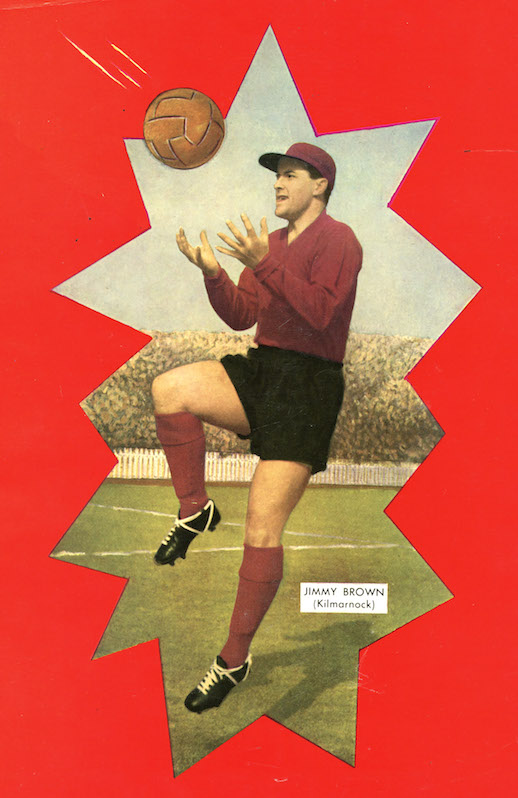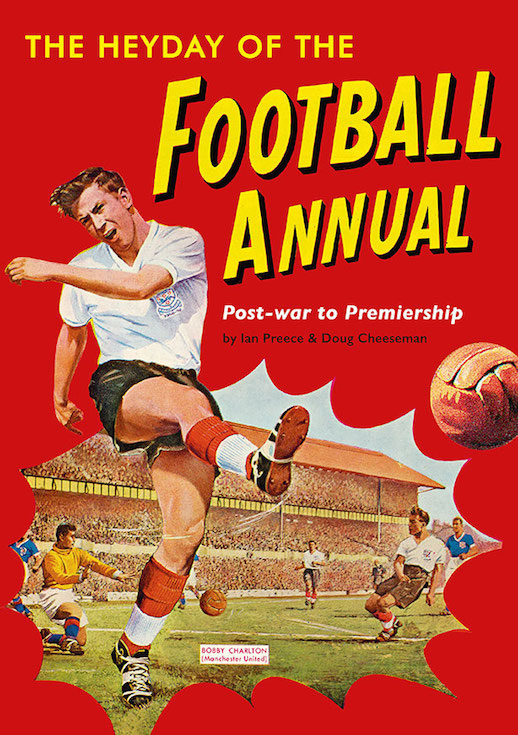 The Heyday of the Football Annual: Post War to Premiership by Ian Preece & Doug Cheeseman (Constable, hardback. 256 pages. Out now)
The Heyday of the Football Annual: Post War to Premiership by Ian Preece & Doug Cheeseman (Constable, hardback. 256 pages. Out now)
Review by John Andrews
It will be forty years next Easter since I went to my first ever football match with my football mad Great Aunt Doris, her in her astrakhan coat and horn-rimmed specs and me in a Millett’s parka adorned with a newly bought rosette, to marvel at a 2-1 victory for Derby County over Aston Villa (John Gidman put the visitors one up before goals from Gerry Daly and Charlie George gave the Rams two points). Watching the game with someone who had been watching it since the war – ‘Don’t worry duck; we’ll beat ’em’ – the smell of the pitch, the way the mud cut up in the tackle, meeting Leighton James on the stairs at half-time – ‘He’ll ‘ave your job when he’s older’ – all of it so vivid even now. In that time I have probably read more words about football than on any other subject. I have consumed the game and in lots of senses the game has consumed me. Mostly my reading comes in the form of the back pages and the detailed study of all of the previous evening’s results and snippets of news about injuries or transfers.
In the days before the internet and even in the days before Ceefax and in the absence of a broadcast on Radio 2, the first you would hear of the previous night’s encounter between Crewe Alexandra and Preston North End would be when you managed to get your hands on the precious back pages of the newspaper. Why did these results, so immediately meaningless, (I supported neither club) have so much resonance? I always looked at the attendance which was never less than thousands in number, even on the archetypal cold wet winter’s night in Crewe. This was worship, this was addiction. These were the days when communication about football and what happened in the game belonged almost exclusively to two groups: the press corps who lived in the pockets of the players and in the shadow of their clubs, and the fans whose hunger for the game and all that surrounded it was never sated. They went and they watched. I still treasure telephone messages that were left for me before e-mail, my favourite of which ran: ‘GOOD NEWS: I have your Season Ticket. BAD NEWS: Barnsley are in the Premiership. Kenny’.
I sometimes wake up at night convinced I am back in the kitchen of our family’s old quarter in War Department Estate 4d, Bushey, listening to the late Peter Jones describe the atmosphere at a midweek European Cup clash at The Baseball Ground, a moment which sounded to me as exotic as listening to the first message from space might to anyone else. Jones’ voice crackled over the long wave. The crowd roared and gasped. The glare of the floodlights filled my mind. It was a visitation.
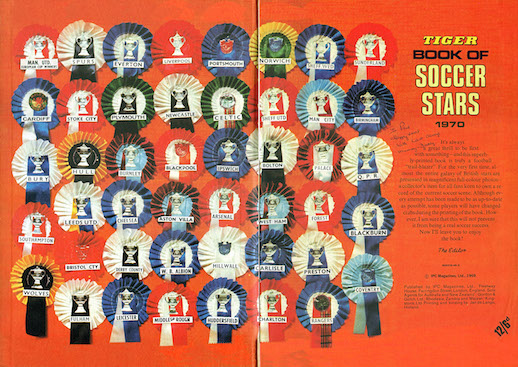
This other world which shimmers like a distant fiction or a mad fantasy in the current era of super leagues is beautifully wrought and rendered in Ian Preece and Doug Cheeseman’s book The Heyday of the Football Annual. This is no ordinary book. Indeed this is no ordinary football book. In fact, there were times when I was reading it when I thought I might even be reading the most authoritative and insightful book on the game ever written. It grabbed me in the same way that Gary Imlach’s My Father and Other Working Class Football Heroes (Yellow Jersey Press, 2005) did, it made me yearn to be crammed hungover into a rusting Fiesta on the way to a game on the outer suburbs of London in the way that Garry Nelson’s Left Foot Forward – A Year in the Life of a Journeyman Footballer (Headline, 1996) did. Its legion of photographs of old stadia made me swoon at the magnificence of the cathedrals of our game, built by the likes of Leitch and Binnie and described so vividly in Simon Inglis’ Sightlines: A Stadium Odyssey (Yellow Jersey Press, 2000). It made me want to be nothing more than a fan for every Saturday afternoon for the rest of my life in the way that A Season with Verona by Tim Parks (Vintage, 2003) still does. It made me cry with recognition just like every other football fan cried when they read Fever Pitch when it was published in 1994 by Gollancz. It made me sad and angry that Sportspages on the Charing Cross Road had closed down and it made me laugh in the way that I hadn’t since I read Frank Worthington’s autobiography One Hump or Two? Yes this book, like Frank’s, is much more than the sum of its parts.
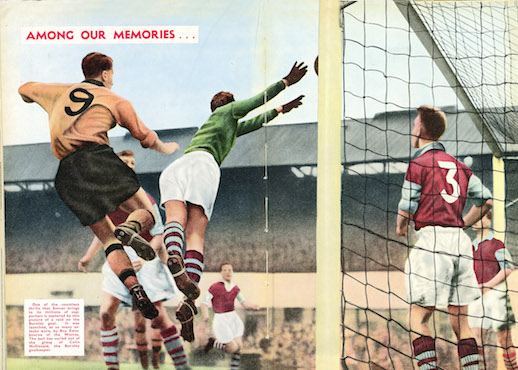
On the surface it is a chronological trawl through every football annual ever published in the second half of the Twentieth Century, but in reality it is a voyage through the imaginations and dreams of several generations of football fans. Its own commentary is driven by an admirable polemic, and just as you’d expect from two long-term staffers from When Saturday Comes, the football fanzine that became an unlikely survivor in the world of magazine publishing, its references are absolutely spot on.
The ‘Introduction’ starts with the line ‘There is a scene in Ken Loach’s Wednesday Play from 1968 The Golden Vision‘. The mention and positioning of this, arguably the greatest football film ever made, at the front of the book is a sign of what is to come over the next 284 wonderful pages. Between them Preece and Cheeseman have culled Annuals and tracked down collections to exhaustively juxtaposition gem next to horror: a photograph of fans ice skating on the frozen pitch at the Shay Stadium (Halifax Town) alongside a photograph of Dave Webb cutting Marty Feldman’s hair is typical of what each turn of the page reveals.
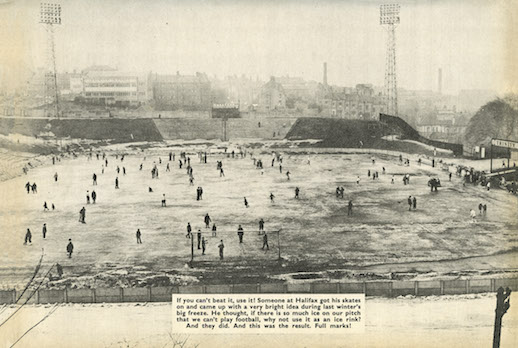
It offers a price guide for what to pay for Football Annuals at Car Boot Sales: ‘Less than £1 buy it anyway, over £1 check the pictures have not been cut out, more than £5 don’t buy it.’ They are all here: Charles Buchan’s Soccer Gift Book, Stanley Matthews’ Football Review, The Topical Times Football Book, packed with scraps of information that to true football fans mean more than who wins the Balloon D’or. From 1964: ‘At Rugby Park, Kilmarnock huge tannoy speakers have been erected, constructed with the same technology – no distortion and huge wattage – as are used on NATO airfields’. The submission, before he died in the Munich Air Crash, that Duncan Edwards’ huge levels of sustained concentration were down to one thing – ‘Well I do quite a bit of fishing’. It is reassuring to know that in 1958 Danny Blanchflower showed no sign of ‘media training’ in The Sportsview Book of Soccer with an assessment of rival clubs, ‘Chelsea – ‘a music hall joke’ and that in The Big Book of Football Champions there was a piece on floodlights entitled WHAT THE FUTURE HOLDS which read ‘Grimsby v Scunthorpe on a Tuesday night?…..Don’t be such a wild dreamer’.
In the days now when there are fewer good writers who also happen to be writers about the game, Heyday turns the spotlight on those whose words became gospel. These were not overblown pundits whose columns were ghosted, but men for whom football was indeed a metaphor for life and for whom writing about it was nothing less than a zealous duty. They were like priests or teachers. In the same vein as Ken Loach sat John Macadam, who wrote for Charles Buchan’s Soccer Gift Book in the 1950s, and dissected the game with an immense respect for his audience. Here was the man who had reserved trawlers to take Grimsby Town fans up the Thames should they have reached the 1939 FA Cup Final (they got knocked out in the Semis) and who left behind an autobiography, The Macadam Road, which described his childhood in a tenement overlooking the Clyde ‘full of tales of scalding porridge, escape from Greenock shipyards, a heavy drinking grandfather prone to getting his banjo out when a certain boat berthed in the morning – (a reunion being on the cards), and various cads, flaneurs, old timers and encounters from the sports writing life.’ He lived on a houseboat in Chelsea with ‘bohemian friends’ and writing his obituary in 1964, Peter Thomson said of him ‘behind that outsized moustache he had the melancholy of a man looking for something he could not hope to find. His ukelele would be much missed on foreign trips’. Can you imagine any football or sports writer exuding such character today – perhaps with the exception of the peerless Henry Winter?
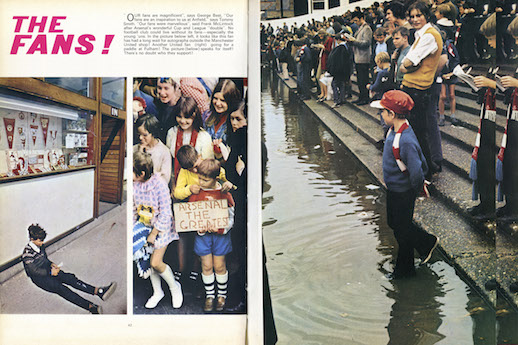
And yet Heyday does not romanticise its subject. It honestly reflects the content of football annuals, much of which was overtly political. A piece from Tony Pullen in Peter Dimmock’s Sportsview Book of Soccer talked about the plight of ordinary fans in 1964: ‘What hope is a ticket to the Cup Final at Wembley? The only people who get them at face value are the socialites, the business executives and the spivs’. Oh, little has changed in many ways. The pages were turned too by what many editors called ‘the wind of chance’ and so tens of thousands of young fans woke on Christmas mornings in the Sixties to graphic pictures of Roy Dwight’s broken leg and of Derek Dooley’s amputation or of an unsmiling Dougie McMillan of Sheffield Wednesday, whose trip to the toilet on the club coach on the way back from a game proved to be ‘his worst experience in football’ – ‘the coach failed to navigate an icy double bend on the A1 and I lost a foot in the wreckage’.
If there is something childlike in men’s obsession with their national game then perhaps it is wise to consider what sort of childhoods made those men. These were generations whose parents had been scarred by war and its aftermath, and who grew up with few comforts. The game offered sanctuary and escape. These were children who, through such organs as football annuals, were educated long after schools were split into Secondary Modern and Grammar. These were children who even in short trousers toured the country alone following their clubs on our recently nationalised railways. The endless variables of the football league tables and the unfathomable law of goal difference taught them mathematics; writers such as Macadam taught them both the spoken and the written word; their science lessons took place in the Chicken Run at Upton Park or in the Gladys Street End at Goodison. Outside grounds they learnt that even heroes had feet of clay and that small acts of kindness are what life is all about. Johnny Green, an autograph hunter, recalls the time Denis Law invited him onto the Manchester United team bus ahead of a trip to Chelsea. ‘I got on the Manchester United team bus and I sat next to him and I was stuck for a word and I sat as the players filed in and nobody really commented, a little card school set up. Then Bobby Charlton came on, late, and as he was walking down the aisle – it was just a characbanc – he said ‘What’s that kid doing here? Get him off the fucking bus’. And Denis Law looked up from his seated position where Charlton was looming over us and said ‘HE’s with me.’ It was quite confrontational and quite emphatic. Charlton sat down. ‘Fuck’s sake.’ I didn’t speak to Denis Law I just sat and glowed. We got to the gates at Stamford Bridge and he said ‘Hang on’ and he got up and went to the front of the coach where the officials were and came back and handed me a ticket ‘Here you go son, enjoy the game”.
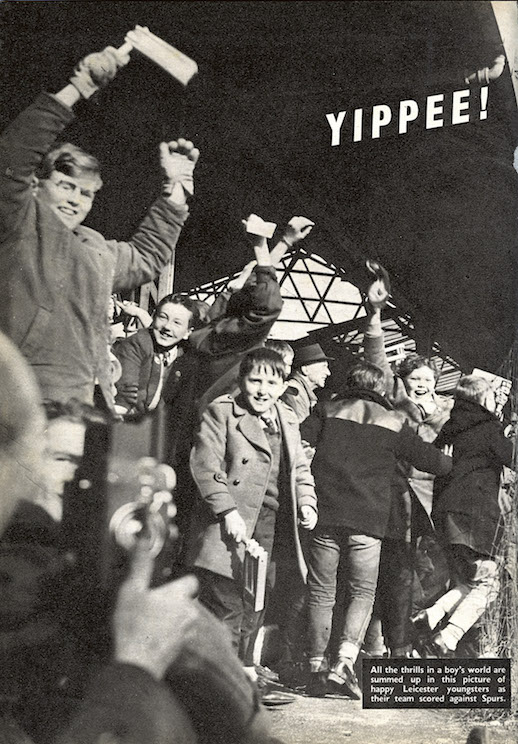
By the same token some boys were weeks away from their own debut in the game and an undisputed seat on the bus, along with an opportunity to tell Bobby Charlton to fuck off himself twice a season in the league or more if you got United in the cups. Peter Osgood was picked up as a 16 year old bricklayer by ‘Music Hall Jokes’ Chelsea when playing for Windsor Corinthians after his Mum wrote to the club to tell them to sign him. A few years later Osgood won the FA Cup with Chelsea (the winner scored by Marty Feldman’s hairdresser) in a Final Replay against Leeds on Manchester United’s ground, whilst the hosts contemplated a decline that eventually saw them drop into Division Two (sent down ironically by a backheel from Denis Law who was then playing for Man. City).
In between the long form pieces and in depth features, Heyday provides snapshots of the game that even the most ardent of fans might not know: from a profile of the mascot at aforementioned Kilmarnock – ‘Wilma the Sheep’ who was fond of eating cigarettes lobbed at her from the crowd, to reports of ‘Strange Things’ -‘YES IT’S HAPPENING – IN BELGIUM’ a headline about a report of ‘football players with adverts for companies on the backs of their shirts’. There are dozens of portraits of the not-so-giants of the game, men such as the one photographed at The Den on page 123: ‘Where have they got to go? After the big freeze British weather got back to normal, lashing rain. Here is Esmond Millon goalkeeper of Bristol Rovers keeping a weather eye open for Millwall raiders’. Oh! Esmond Million. But there are famous names too inevitably, Best and Moore, and even one who played with both in the 1970’s Fulham side interviewed by Maureen Cleave for the first ever London Soccer Annual: ‘He thinks he might have been a priest if he hadn’t become a footballer, ‘something different something nobody else does’ and would like an indoor forest in his house, ‘so I can shoot rabbits at will in private without being harangued by animal rights activists.’ Oh, Rodney.
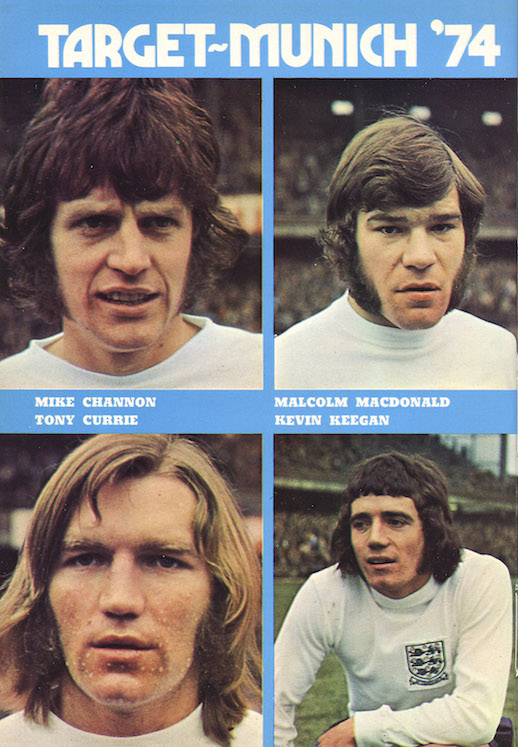
Heyday is epitomised by a profile of Davie Robb at Aberdeen putting The Richard Harris Live Album on the turntable and playing with his cat. It is so splendid it is impossible to review impartially or completely. It is up there with Julian Germain’s In Soccer Wonderland (Booth-Clibborn Editions, 1994) and rivals Bob Stanley and Paul Kelly’s Official Match Day Football Programmes (Post-war to Premiership) (Fuel, 2006). I could have written dozens of reviews of it from dozens of different perspectives, so dense and so rich is it. But to summarise what this book is about I give you the words of one of the authors themselves: ‘The Tiger Book of Soccer Stars 1970 is a real beauty and in some ways could be considered the spiritual touchstone of THIS book. I came across it in the late 80s in either a junk shop or a car boot sale in South London and had a Proustian moment on seeing the team line-up of Nottingham Forest, the very photo my Dad had nailed to the door of our outside toilet. What colour, there’s not a single black and white image. It’s Britain’s equivalent of the William Eggleston Collection’.
So buy this book alongside all the others I have mentioned in this review, if you do not already have them – cancel your Sky or BT subscription to do it if you have to. Reclaim your soul and with it a bit of our national game’s too. It and they will sustain you for life and give you a glimpse of the truth and the beauty such as was captured by Peter Robinson for Football League Review. His were true portraits of the game, similar to the spellbinding work of Stuart Roy Clarke. ‘He photographed the tea bar, the floodlights, a pair of hands on a ledge behind a walled in ticket window, the gas works behind the corner of a ground; the entrance to the car park at the Valley or Joe Mercer and Bill Shankly deep in conversation in a bare looking corridor at Anfield’.
